DIY Green Powder aka Super Greens
Learn how to make your own super green powder by dehydrating greens and adding a powerful nutrition ingredient to your long-term food storage!
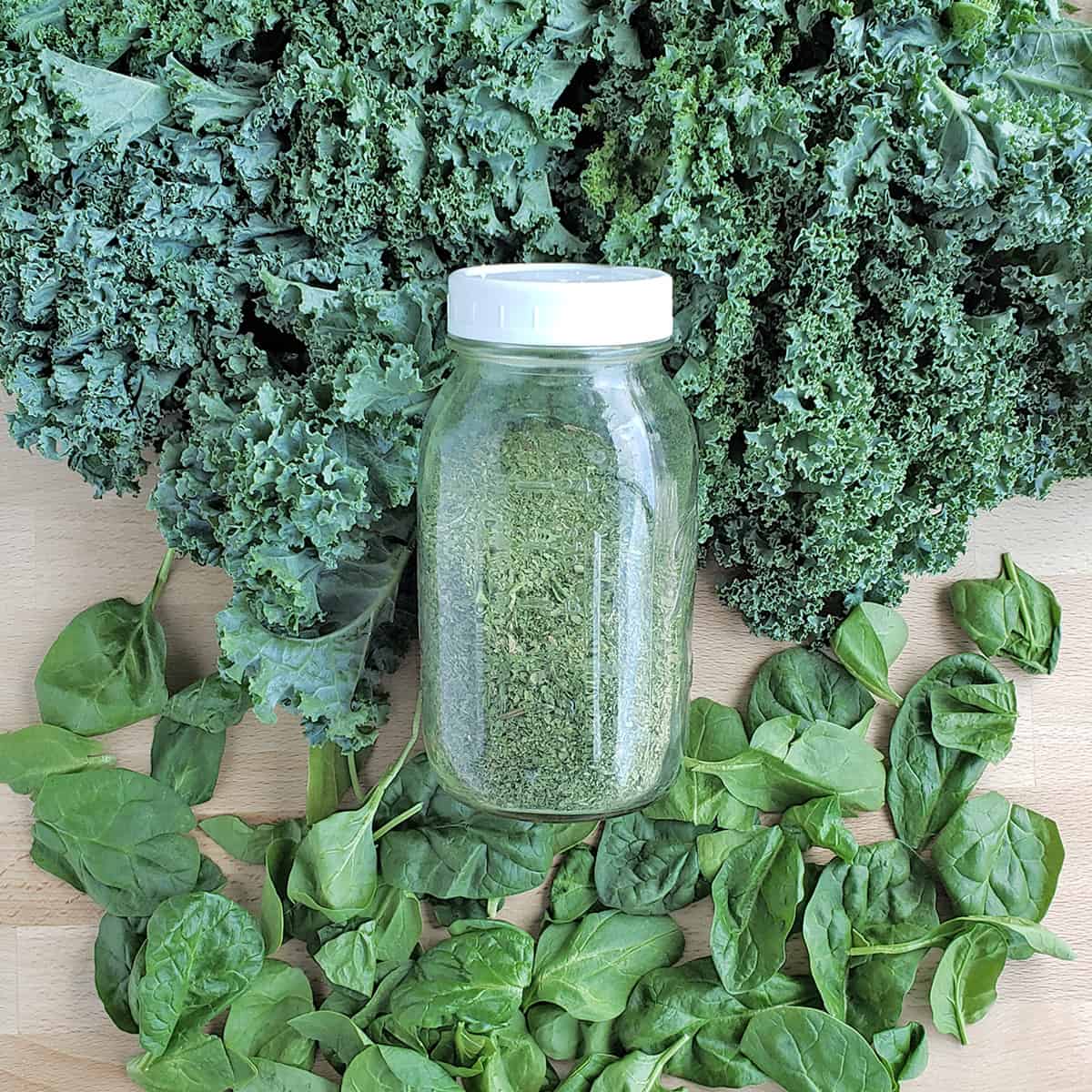
All it takes is one look at slimy, gross, and icky spinach oozing out of a can. Then you might be like me and hate greens forever.
I finally learned to stomach spinach by adding some to ricotta for manicotti or three leaves onto a sandwich to replace lettuce.
But I never, ever, ever put greens on my plate, cooked or otherwise. I’m a southern girl and have never eaten cooked collard or mustard greens. Ever. Just the smell makes me say no without the thank you.
It wasn’t until I’d really begun my journey to a fully purposeful pantry that I learned there is a new way for me to make use of the dark leafy greens. I turn them into nutritious green powder, which I can add to countless dishes.
Let me show you how to do it.
What Greens Can I Use to Make Green Powder?
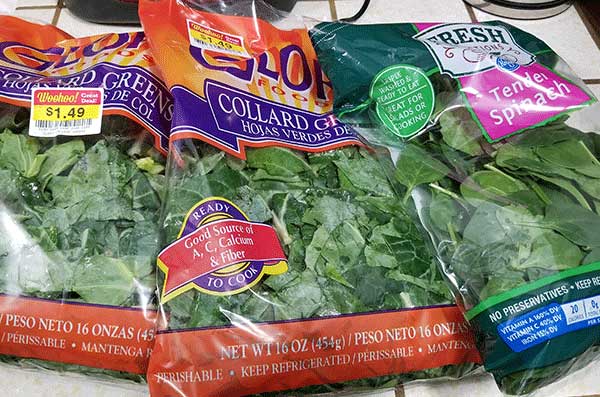
Is it green? Then you can use it! It really is that simple.
- Herbs – whenever I have leftover herbs, I toss them in the pile along with my greens, or I’ll hang those herbs to dry, and add to my powder and shake well!
- Alfalfa grass
- Barley Grass
- Beet Greens
- Borage
- Broccoli
- Cabbage
- Carrot tops — parsnip, too!
- Cauliflower
- Celery leaves
- Chard
- Collard
- Daylilies – NOT the cultivated kind.
- Grape
- Greens – mustard, turnip, collard, swiss chard, etc.
- Kale
- Lettuce – yes, you read that correctly! Lettuce! Don’t bother with Iceburg, but the more color lettuce has, the better!
- Moringa
- Mustard
- Nasturtium
- Pea plant leaves & pods
- Pumpkin leaves – absolutely!
- Purslane
- Radish greens
- Raspberry leaves (good for teas)
- Spinach
- Spirulina
- Squash
- Strawberry
- Sweet potato leaves
- Swiss Chard
- Turnip
- Weeds. Yes, you read that right – weeds.
- Wheatgrass
You might be interested in: How to Dehydrate Parsley
Other items you may wish to include
- Celery
- Beet powder – but this will give your powder a brown color, just so you know!
- Green bean powder
- Pea powder or Pea pods
- Broccoli – while you can add it, adding too much can alter the flavor of green powder as broccoli has a very strong flavor.
You can add anything to the powder you like, but leafy greens are the base of the powder.
What not to add to Green Powder
- Many garden greens are not digestible or downright poisonous to humans. Here are a few leafy greens you shouldn’t add to your green powder.
- Tomato leaves
- Potato leaves (sweet potato leaves are fine)
- Rhubarb
- Pepper leaves – this is personal choice, but as a nightshade, it can be problematic to some folks.
- Vegetables – many of the veggies we would consider green give off a strong flavor that might make your green powder taste surprisingly like broccoli 😉 So make vegetable powder with them instead!
- Fruits – because of their sugar content, fruits should be done on their own so that clumping isn’t an issue.
Do I Need to Blanch Greens Before Dehydrating?
My rule of thumb for dehydrating foods is this:
“If you eat it cooked, blanch/steam it before dehydrating.”
Before eating, steaming dark leafy greens, like mustard greens or kale, is thought to help reduce oxalic acid, which makes their nutrients more available to be absorbed into your body. It also helps soften the stems of the plant, which are so full of concentrated nutrition, making them less of a waste product.
Blanching can also help stop the enzymes that make your food degrade on the shelf. Since greens and green powder have a shorter shelf-life than other dehydrated foods, in general, it is not necessary
Note: B vitamins are lost in the blanching process since they are water-soluble. However, it will be lost in any recipe you cook with green powder.
So the answer is, no! Blanching is unnecessary since you’ll be cooking it in most applications anyway!
Will blanching kill bacteria?
James Rogers, Ph.D., director of Food Safety and Research at Consumer Reports, suggests cooking greens thoroughly to kill E-Coli and other related bacteria.

How to Dehydrate Greens
Quick Start: Dry greens at 95°F / 35°C for 6-12 hours to retain vitamins and minerals.
1. Wash greens thoroughly
Soak greens in a vegetable wash of 1 part vinegar to 2 parts water and 2 TB lemon juice. No need to rinse, but you can if you’d like. Use a Salad Spinner to remove most of the excess moisture.
2. Remove any unwanted stems and veins
De-stem your greens.
They can either be rough chopped to do separately or saved for compost
Note: If you have steamed your greens first, you may not need to remove the stems, but check them all to be sure and remove any still tough ones.
3. Lay your leaves on your dehydrator trays.
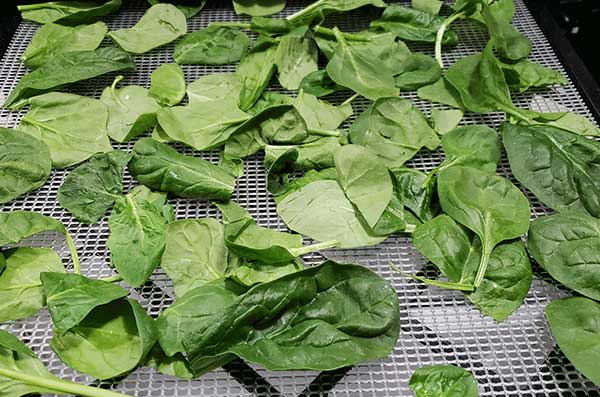
It’s okay if they touch or if you pile them on a bit. Leaves shrink up to 1/4 to 1/3 of their size when dehydrated, so there is lots of room for movement.
5. Set your dehydrator to herbs or 95°F / 35°C.
Greens are heartier than herbs, so I set my dehydrating temp to the lower end but a bit higher than herbs. Greens usually dry within 6-10 hours, depending on the moisture of your home, the moisture content of your greens, and your dehydrator.
If you would prefer to go a little more quickly, you can set your temperature to Vegetable or 125°F / 52°C. Remember that you don’t want to ‘cook’ those greens – you want to save as much nutritional value as possible.
Oven Directions:
If you do not have a dehydrator:
- Set your oven to its lowest temperature.
- Lay your leaves out on cooling racks,
- Prop your door open.
- Dry approximately 2-3 hrs., but check often.
Not only do you want to keep the temperature of your oven down, but you also want the circulating effect of having the door open. This allows it to release as much moisture into the outside air and not trap it in the oven.
6. Test for dryness
When leaves AND stems crumble when crushing, your greens are done.
7. Condition
Because the stems on greens are often very thick and fibrous, they will hold more moisture than the leaves, which means they may hold on to moisture.
Conditioning allows you to test your dehydrated produce to ensure that no moisture creates an environment where mold may form.
Simply put your greens into a jar with a lid. Shake once a day for a week and watch for any moisture formation in stems or on leaves. Put it back into the dehydrator if you see any.
If you see even a little mold forming, throw it all out. It’s not safe to pick out where you see the mold since it can be throughout the greens and not visible.
8. Store
Store greens in an airtight container for about 12-18 months. I use a large plastic container with an airtight lid for large quantities.
This allows you to grab a handful to add to any meal you’re making such as my cottage pie made with dehydrated foods, spaghetti, meatloaf, soup, etc.
How to Make Green Powder
1. Powder the dry leaves
Fill your blender with the dried leaves, pulse a few times, and then set on a low speed to powder.
Note: If you have a Blendtec or Vitamix, be sure not to blend so much that you’re cooking those leaves. But blend at lower speeds to allow them to fully powder. I use a Ninja blender and will need to do a 2nd pass on the thicker leaves like collard or mustard.
2. Strain powdered leaves into a storage container

This helps keep out the larger flakes of greens. You can then return those to the blender/processor and whirl them around for another ride if they are not fine enough for you.
Yield:
Just how much powder will you get from dehydrated greens? The yield will vary on how big your leaves are and which greens you are dehydrating.
1 C of packed greens = 1/2 C dehydrated greens = 1 TB+ powdered greens
This ratio is very generic and will depend on how thick your greens are, etc.
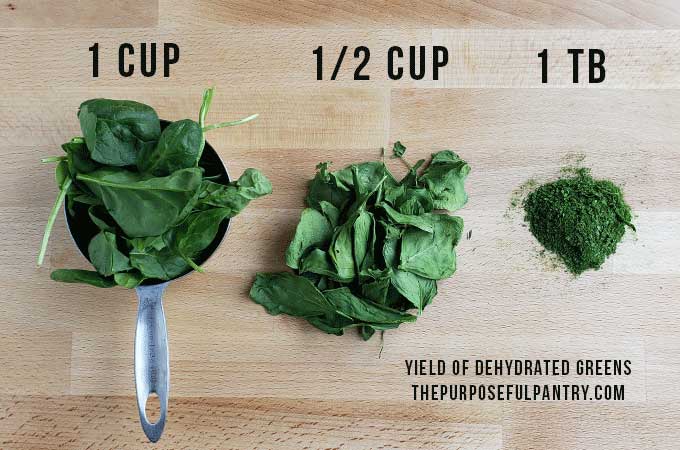
Don’t think it’s such a small amount for such a big job. You now have concentrated iron, magnesium, potassium, vitamins K, C, and E, phytonutrients, and small amounts of omega-3 fatty acids. It’s a powerhouse of nutrients in a jar.
If that seems daunting, start with the pint-sized jars and work your way up. You’ll be amazed at how quickly your jar fills once you start!
How to Store Green Powder
Ideally, you want your green powder stored in an airtight container that will be kept in a dark, cool, dry place. I keep a working jar next to my stovetop to add the powder to my cooking. This generally lasts about three months.
Ideally, you want your green powder stored in an airtight container that will be kept in a dark, cool, dry place.
You may also want to consider vacuum-sealing your greens into mylar bags or food storage bags for long-term shelf storage. Or store them in the freezer.

Is There a Green Powder Recipe?
The best greens powder recipe is the one you use daily. Use the greens you have access to all the time.
While there are commercial super greens powders like Athletic Greens and many other brands, they can be very cost prohibitive for the average family.
This can be an ever-changing mixture of those greens listed above as you harvest or purchase from the grocery store.
Suggested Uses of Green Powder
You can add this nutritionally boosted powder to just about anything you cook. Are kids not getting enough greens? Green Powder is a great way to sneak extra into their everyday foods.
- Sprinkle onto salads
- Bulk up your favorite herb mixture
- Mix into meat mixtures – Meatloaf, tacos, shepherd and cottage pie, and more.
- Sprinkle into casseroles
- Make real green eggs! Mix into any egg dish that you are doing like scrambled eggs, frittatas, omelets, etc.
- Add to smoothies – if you’ve run out of fresh greens, no one says you can’t use dried ones! I use approximately 1 TB of greens in a full blender)
- Add to sauces – adding green powder to any hearty sauce is another great way to boost nutrition without really affecting the flavor.
- Color pasta – use your favorite homemade pasta recipe and replace some flour with green powder to get vibrant green pasta.
- Egg muffins – we do egg muffins (a layer of greens, a layer of meat, a layer of cheese, a cracked egg (or egg scramble) and cook for 20 min. Sometimes, instead of actual greens, which can be a texture issue for my youngest son, I use a nice heaping teaspoon of green powder instead)
- Green Powder Capsules – a way to supplement our greens intake and give ourselves a little boost.
Does Homemade Green Powder Dissolve in drinks?
Dehydrated green powder made at home does not dissolve like green powder mixes. When dehydrating, you are left with the fiber, which does not dissolve when mixed with liquid. Commercial varieties are usually freeze-dried.
Try this, instead:
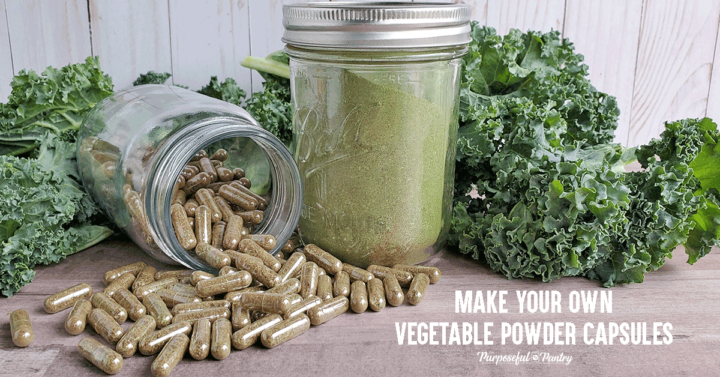
Want to learn to do a little more? Try this with Vegetable Powders!
Darcy’s Tips:
- Chop the leaves and stems – for heartier greens such as mustard, collard, turnip, and other large leaf varieties, chop the leaves down to help fit more onto a tray and make storage easier.
- Consider keeping a container full of dried greens to take by the handful to add to spaghetti or other dishes.
- When placing your greens into a dehydrator, use a piece of mesh or parchment paper on top of them to help condense them as you push them into the dehydrator. It adds very little to the drying time. This means you don’t have to remove a tray for machines like Exclaiburs!
- If you only want green powder, you can blend your greens in a good blender and dry them like fruit leather.
- This green powder is not quite like the green superfoods powder you can purchase in most retailers such as Athletic Greens or Balance of Nature. It will not dissolve the same way, and the makeup is what you choose t put in it. It is best for including in things, not dissolved in water.
An airtight container such as a mason or canning jar, a spaghetti sauce jar, a mylar bag, etc.
DIY green powder is good for about a year if stored in an airtight container in a dark, cool, dry place.
Vitamin loss with food dehydrating happens with higher heat. Vitamins A & C are depleted with longer exposure to eat, which is why I recommend doing greens at 95°F / 35°C to retain those nutrients. The vitamin B family is lost in blanching as it is a water-soluble vitamin. However, it is important to note, you will lose those vitamins in any cooking process you do with the greens after.
Yes – you can dry the stems of edible leafy greens by stripping the leaves, chopping up the stems and drying them. You can use a food processor to get small pieces to help them dry more easily before powdering. Some folks like to blanch those stems to help reduce
I use the Excalibur 9-tray Dehydrator (like this one from Amazon. However, you can use almost any dehydrator on the market. I also recommend the Cosori for a more affordable option that is really quiet!
I hope you’ll give this a try! How can you think of using Green Powder to boost your family’s nutritional intake?

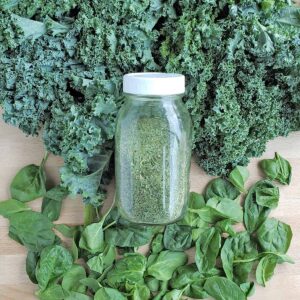
DIY Super Green Powder
Equipment
Ingredients
- 1 LB Greens
Instructions
Dehydrate Greens
- Wash greens well
- Place on to dehydrator trays, they can overlap
- Dry at 95°F / 35°C
- Test for dryness – should completely crumble in your hand
- Condition
- Store in an airtight container
Make Super Green Powder
- Place greens in the grinder / blender of your choice
- Process until a smooth green powder is made
- Store in an airtight container for up to a year.
Video
Darcy’s Tips
Nutrition
Nutritional information is an estimation only. Nutrient information for dehydrated foods is based on fresh. Use 1/4 of the servicing size for the same nutrient information. Thus 1 Cup of fresh fruit has the same sugars as 1/4 dried.
©ThePurposefulPantry. Photographs and content are copyright protected. Sharing of this recipe’s link is both encouraged and appreciated. Copying and/or pasting full recipes to any social media is strictly prohibited.

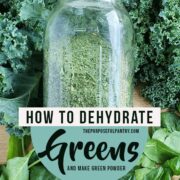
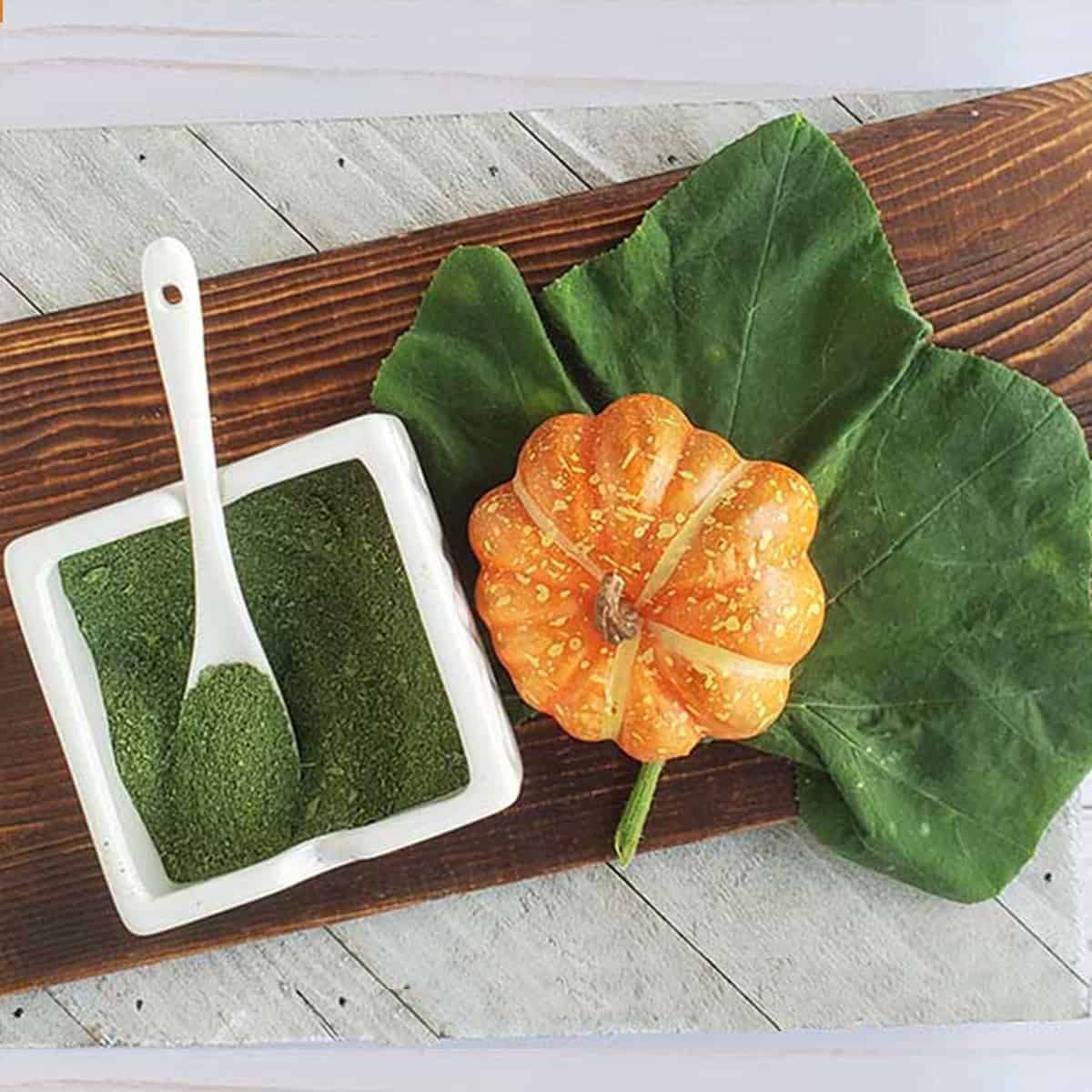
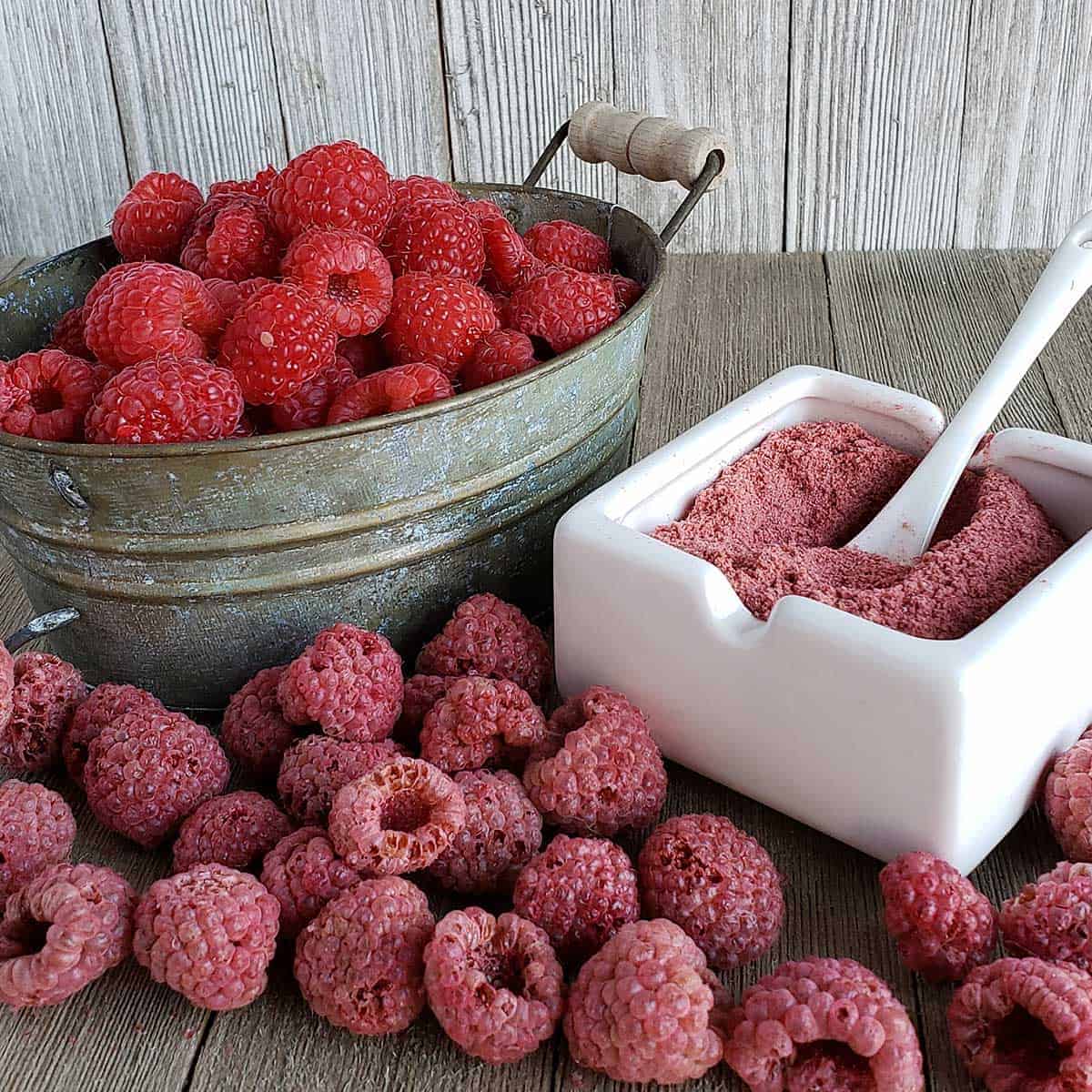
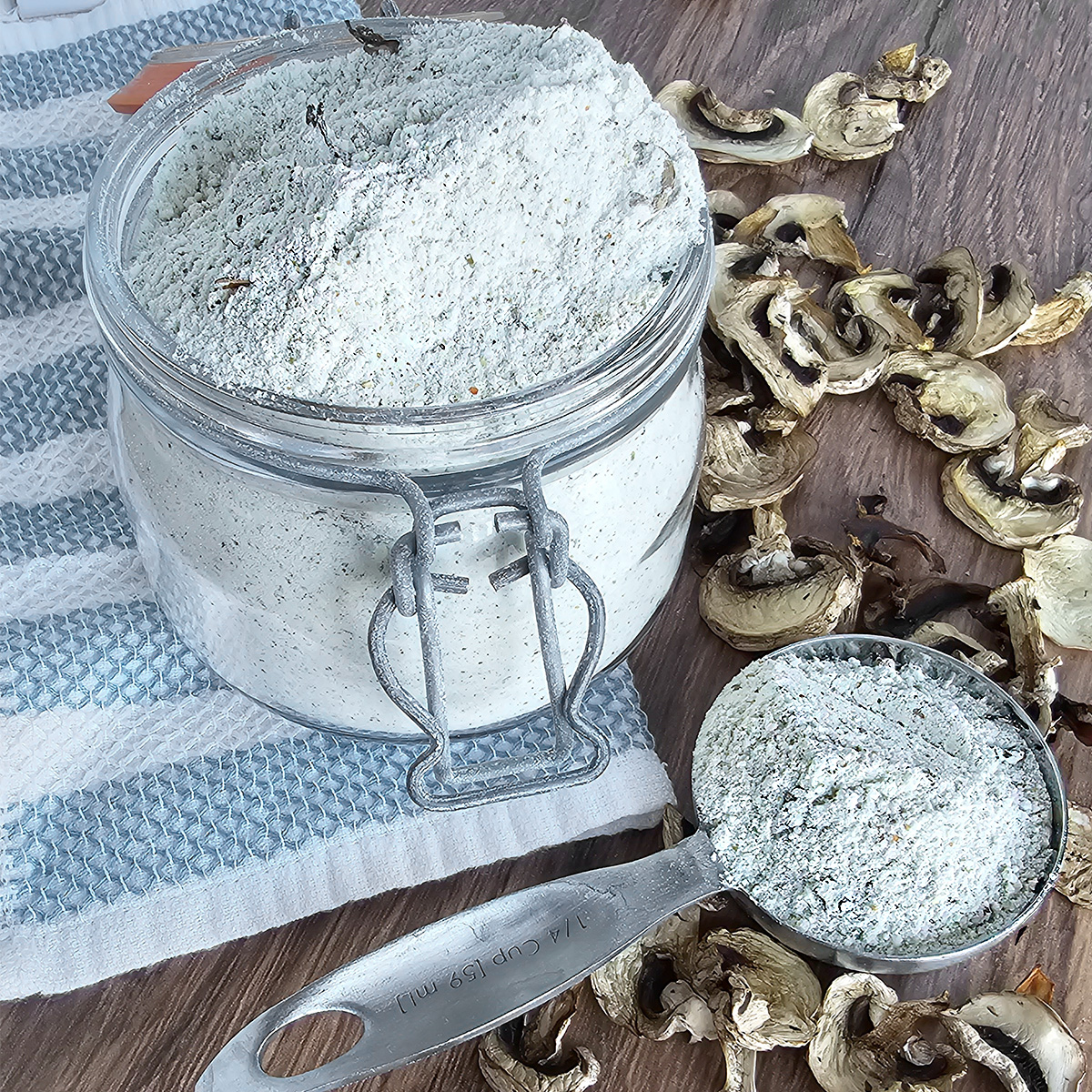
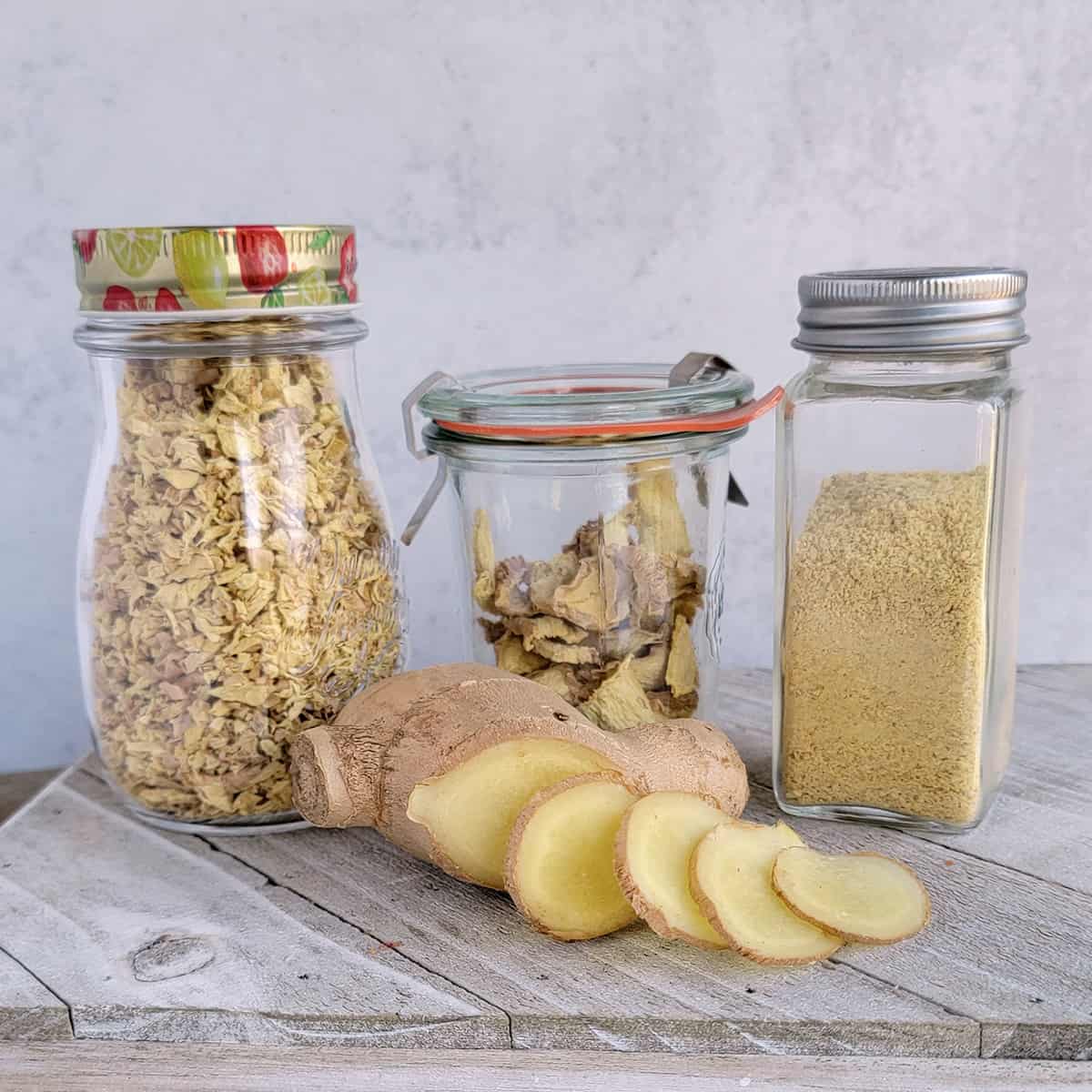
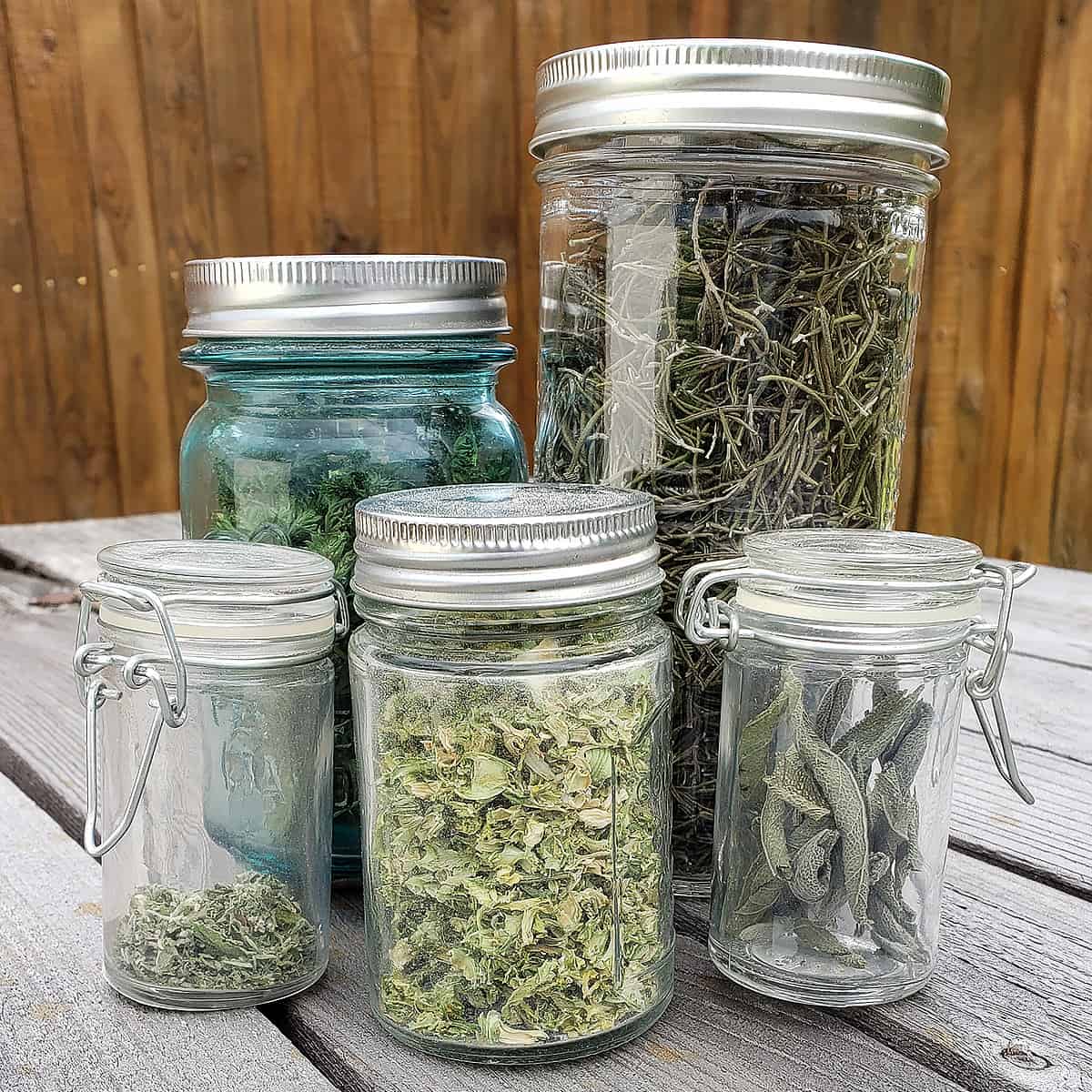
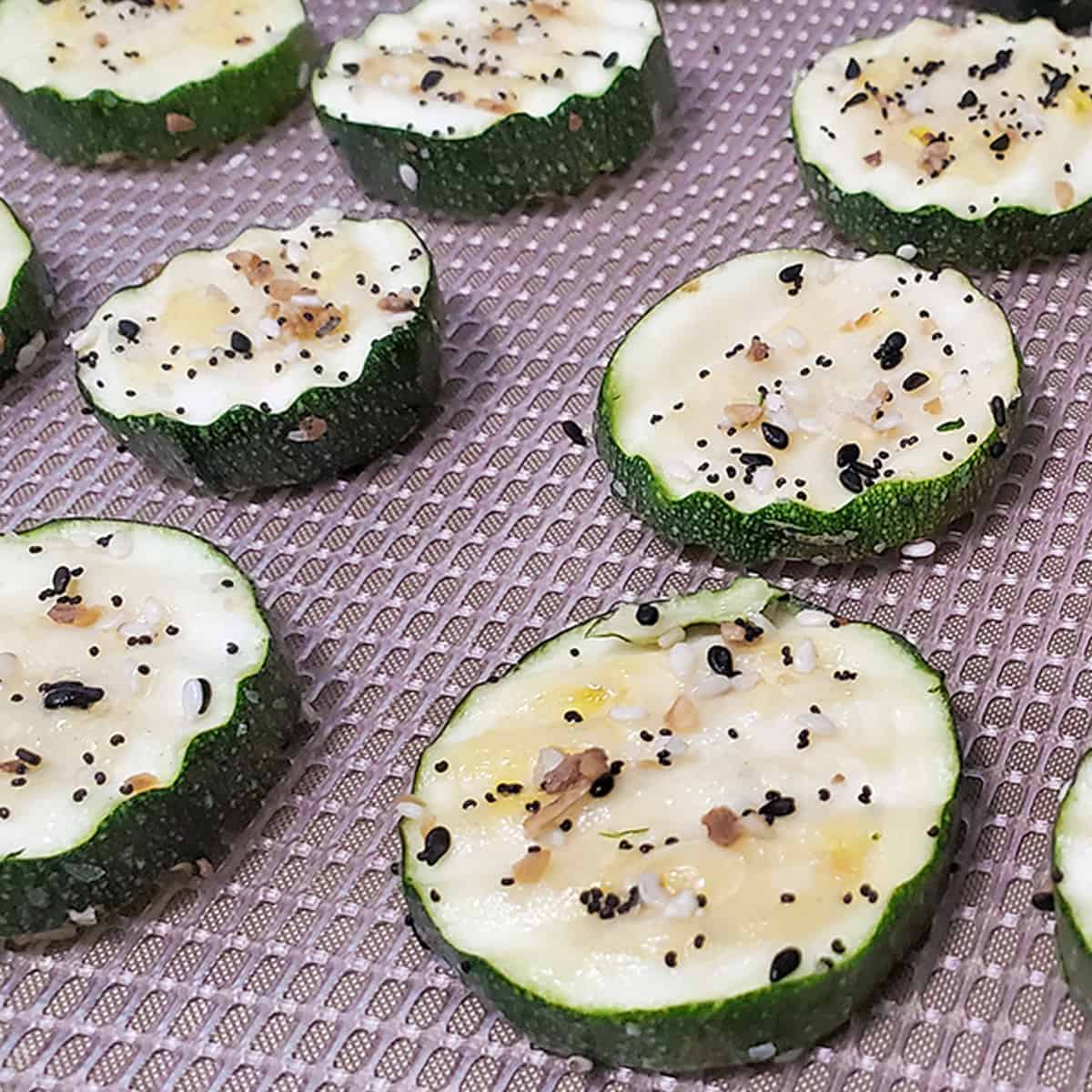
Darcy, I picked the lettuce from the garden and should have done it slower. It is wilted and we only want to dehydrate it. I don’t want to a have to freshen it up dry it again, should I not use it if it is one day old and wilted? I was using it by chopping it fine and then adding to dehydrate trays….it dehydrated nicely. Any advice on using what is wilted as there is still plenty to take advantage of……I learned to do it in batches and then pick more.
The initial wilt is just a loss of water, so yes, go ahead and dry it. I wouldn’t do it if it’s day sold because you’ve been losing nutrients along with the water loss, but day old is fine!
What does point #5 mean by “Condition”?
From the post: Because the stems on greens are often very thick and fibrous, they will hold more moisture than the leaves do, which means they may be holding on to moisture.
Conditioning allows you to test your dehydrated produce to make sure that no moisture is creating an environment where mold may form.
Simply put your greens into a jar with a lid. Shake once a day for a week and watch for any moisture formation in stems or on leaves. Put back into the dehydrator if you see any.
If you see even a little mold forming, throw it all out. It’s not safe to just pick out where you see the mold since it can be throughout the greens and not visible.
I have an abundance of healthy bean plants. The leaves are spotless. Can I dehydrate the leaves for greens powder.
Yes – as per the list above 😉
Hi! Lovely tips! Do you know if is there any safe ingredient to mix with the green powder to make it last longer?
No, there isn’t.
I am intrigued. I have frozen kale and spinach. Could I use the frozen veggies? Would I need to thaw them first? And would I need to wash them? Do you have any recipes for using frozen veggies to powder?
https://www.thepurposefulpantry.com/dehydrate-frozen-vegetables/
How much of each of the greens do you use?
There is no ratio, Connie – green powder is an ever-evolving mix of whatever greens you have going at the time.
I bought an Excalibur 9 and it has preset Temps of 122 degrees and 131 degrees. All the directions for veggies say to dehydrate at 125. So which setting would be best.
122F – the temp doesn’t matter too much except with proteins or if you’re trying to go low enough to keep a raw food diet. Go with the lower.
My friend has a very large organic garden and brought me more lettuce than I can eat fresh yesterfay. So its in the dehydrator now and I can’t wait to bring some powder over for my godson who is struggling to eat lately.
That was very kind of your neighbor – and of you to share!
can I dehydrate some of my leaves from my picked turnips if they have some bug holes in them for use for green powder?
Would you eat them normally? Then yes.
I make a quick “pesto” with my green powder. Throw some olive oil, sunflower seeds, garlic and black pepper into a blender. Grind it all up. Then mix in by hand some green powder and Parmesan cheese. Do measurements according to your own tastes. I love to spread this on some fresh bread or use it as a dip.
That’s a great idea!
How creative! I will be sure to try this on my next batch of bread. Thanks.
Can I add cabbage to the mix?
You can add whatever you’d like!
I was interested to read your post. I actually have dehydrated greens before but then haven’t been good to remember to use them. You have a lot of good information and suggestions on how to use it. I’m going to try to do this more often. Maybe I’ll keep a little on the counter just to remind me. I also have that same Excalibur and love it!
Glad it helped you, Michelle! I have to have everything handy to remember, too!
Thank you for the post. How long will the green powder last in an airtight glass jar or vacuum sealed?
Thanks so much
Most powders are good from six to twelve months.
Hi Darcy….I have some steamed, then frozen Kale & Spinach. Can I dehydrate these and if so ‘how’? thanks sooooo much! I love your blog and fb page…enough so that I went I purchased another dehydrator as my 5 tray Nesco wasn’t enought!
Hi, Pam – you certainly can dehydrate it. You’ll need to thaw it out so that you can lay it out on your racks flat. Then dehydrate at 95F just like fresh until crispy!
And thanks for those kind words! That means a lot to me!
I just love your post. I don’t eat vegetables and just recently found this method to dehydrate vegetabley and make a powder out of them. Do you think if I blend every vegetable together and than dehydrate that puree, will it come out good?
You would still need to cut and blanch them first, anyway, and the leather would turn out more brittle than a fruit leather simply because it is missing the sugars. But I can’t see why it wouldn’t if your eventual desire for the veg is powder.
Absolutely wonderful information. Thanks for sharing. Now I know how to dehydrate all those salad greens.
Great!! Let me know how it works for you once you get going with it!